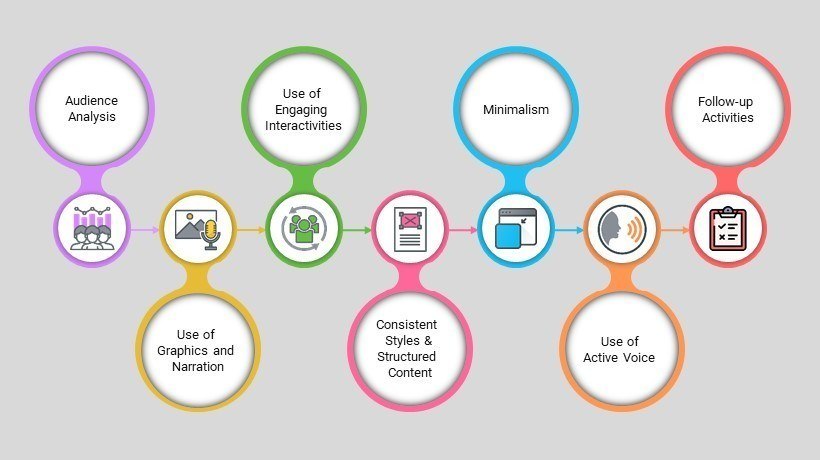How To Use The Minimalist Theory In eLearning
The Minimalist Theory is attributed to J.M. Carroll, and is based on constructivism. Carroll stated that "Adult learners are not blank slates; they don't have funnels in their heads; they have little patience for being treated as 'don't knows'." [1]. Adult learners already have a wealth of experience and prior knowledge tucked away in their memory, which should be regarded as invaluable assets. It is our job, as eLearning professionals, to use instructional activities and materials that support online learners and give them control over their personal learning path. In other words, we must minimize the usage of eLearning resources that stand in the way of their progress.
The Minimalist Theory Framework
According to J.M. Carroll, the Minimalist Theory consists of a basic framework that combines self-directed learning activities with technology. If you are taking this approach, your eLearning course design should have these 6 basic components:
- eLearning tasks should be self-guided and meaningful. Online learners must be able to progress at their own pace, determine their course of action, and relate to the subject matter on a more profound level.
- Online learners should be offered realistic eLearning activities, content, and projects immediately following the lesson. This gives them the opportunity to apply what they have learned as soon as possible, which increases information retention and recall.
- eLearning courses should encourage self-directed improvisation, problem solving, and reasoning. This is typically achieved by integrating active eLearning activities that prompt online learners to put their knowledge into practice.
- All eLearning materials and activities should focus on "error recognition and recovery". Thus, every eLearning course should encourage learners to learn from their mistakes and determine how they can overcome them.
- eLearning content should emphasize the relationship between the subject matter and real world applications. Online learners should be aware of how they can use the information or skills in real world environments.
- eLearning materials and activities should consider the prior knowledge and experience of online learners, such as their preexisting knowledge base, background, and skill sets.
4 Tips To Apply The Minimalist Theory In eLearning
Here are 4 tips that can help you apply Minimalist Theory in eLearning course design, which are loosely based on Greg Kearsley's recommendations [2]. Kearsley is one of the most notable proponents of the Minimalist Theory:
- Follow each online lesson with an immersive eLearning activity.
Online learners must be able to apply knowledge as soon as they've completed an online module or lesson, and an immersive eLearning activity is one of the most effective ways to accomplish this. More importantly, the proceeding eLearning activity must offer them the chance to reinforce ideas and commit the information to the long-term memory. For example, a serious game allows them to practice what they've learned and identify connections between related concepts. Best of all, it's done in an exciting and engaging way. It also appeals to their competitive nature, as they can progress through each level of the eLearning game, earn points and badges, or even advance up the leaderboard to surpass their peers. - Keep it active.
eLearning courses that are designed based on the Minimalist Theory focus more on technology and interactivity than passive eLearning activities. For example, drag-and-drop interactions would be chosen over reading a passage or listening to a lecture. Every piece of eLearning content should allow the online learner to solve problems using the online resources that are available and arrive at their own conclusions. Instead of simply asking the online learner a series of questions, encourage them to take it to the next level by creating a blog that centers on a sub-topic. This prompts them to put the information into their own words and builds creative thinking skills. Active eLearning materials help online learners to connect to the subject matter in a more meaningful way, which makes it more likely that they will remember all of the key concepts and ideas. - Turn mistakes into opportunities.
One of the core principles of Minimalist Theory is "error recognition and recovery". In other words, online learners must have the ability to make mistakes, acknowledge them, and then figure out how they can recover from them and move forward. Simulations and branching scenarios are two of the most effective activities for mistake-driven learning. They help online learners to explore the repercussions of their decisions in a safe environment, so that they can identify what they did incorrectly and then modify their performance behaviors. Instead of having to build their skills on-the-job or determine how to approach a problem, they can test out their assumptions by participating in an interactive branching scenario. - Let online learners choose their personal learning paths.
The Minimalist Theory relies heavily on self-contained and self-directed learning. Therefore, online learners should be given the power to develop a personal learning path that allows them to achieve their specific goals. This path should include their preferred delivery methods and eLearning activities that can be completed in any order. Ideally, these learning paths should build upon their existing knowledge and the existing mental schema. This helps to expand their knowledge base and reinforce ideas and concepts they've already learned. Ask them to design a personal learning path at the beginning of the eLearning program and then schedule periodic eLearning assessments and eLearning course evaluations to gauge their progress.
The Minimalist Theory by J.M. Carroll can help you create more powerful and concise eLearning content. The key is to identify what your online learners need and then create realistic, self-guided eLearning materials that give them control over the process. This can also empower and motivate distracted online learners who require more incentive to actively participate.
Every online learner has different preferences and needs, which means that you may have to consider additional factors when designing your eLearning courses. Read the article 7 Tips To Create The Perfect eLearning Conditions and discover how to create a solid foundation for your audience to build upon.
References:
- Carroll, J.M. (1990). The Nurnberg Funnel, Designing Minimalist Instruction for Practical Computer Skill. Cambridge, MA: MIT Press
- Kearsley, G. (1994). Minimalism (J. M. Carroll)









